Sen Wu
NECA: Network-Embedded Deep Representation Learning for Categorical Data
May 25, 2022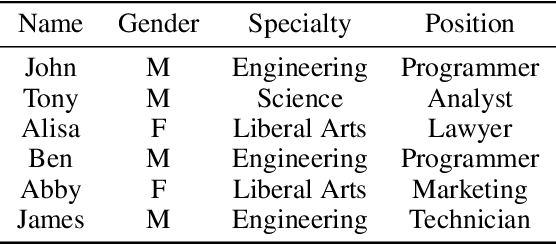
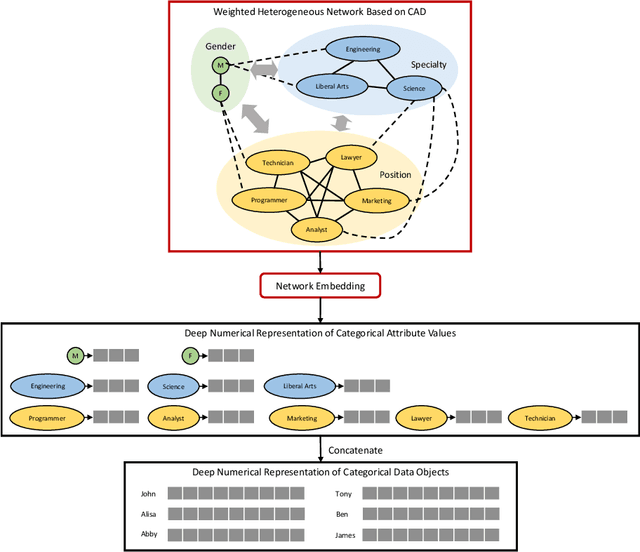
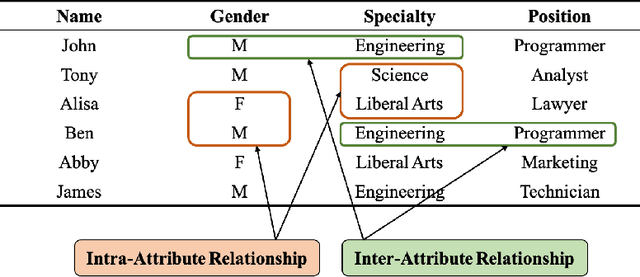
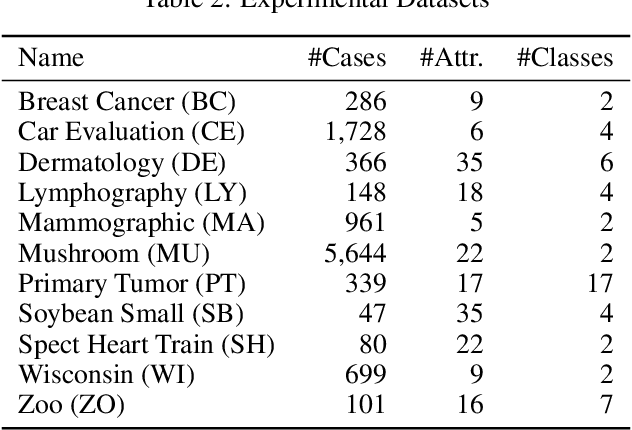
Abstract:We propose NECA, a deep representation learning method for categorical data. Built upon the foundations of network embedding and deep unsupervised representation learning, NECA deeply embeds the intrinsic relationship among attribute values and explicitly expresses data objects with numeric vector representations. Designed specifically for categorical data, NECA can support important downstream data mining tasks, such as clustering. Extensive experimental analysis demonstrated the effectiveness of NECA.
Metadata Shaping: Natural Language Annotations for the Tail
Oct 16, 2021



Abstract:Language models (LMs) have made remarkable progress, but still struggle to generalize beyond the training data to rare linguistic patterns. Since rare entities and facts are prevalent in the queries users submit to popular applications such as search and personal assistant systems, improving the ability of LMs to reliably capture knowledge over rare entities is a pressing challenge studied in significant prior work. Noticing that existing approaches primarily modify the LM architecture or introduce auxiliary objectives to inject useful entity knowledge, we ask to what extent we could match the quality of these architectures using a base LM architecture, and only changing the data? We propose metadata shaping, a method in which readily available metadata, such as entity descriptions and categorical tags, are appended to examples based on information theoretic metrics. Intuitively, if metadata corresponding to popular entities overlap with metadata for rare entities, the LM may be able to better reason about the rare entities using patterns learned from similar popular entities. On standard entity-rich tasks (TACRED, FewRel, OpenEntity), with no changes to the LM whatsoever, metadata shaping exceeds the BERT-baseline by up to 5.3 F1 points, and achieves or competes with state-of-the-art results. We further show the improvements are up to 10x larger on examples containing tail versus popular entities.
Cross-Domain Data Integration for Named Entity Disambiguation in Biomedical Text
Oct 15, 2021Abstract:Named entity disambiguation (NED), which involves mapping textual mentions to structured entities, is particularly challenging in the medical domain due to the presence of rare entities. Existing approaches are limited by the presence of coarse-grained structural resources in biomedical knowledge bases as well as the use of training datasets that provide low coverage over uncommon resources. In this work, we address these issues by proposing a cross-domain data integration method that transfers structural knowledge from a general text knowledge base to the medical domain. We utilize our integration scheme to augment structural resources and generate a large biomedical NED dataset for pretraining. Our pretrained model with injected structural knowledge achieves state-of-the-art performance on two benchmark medical NED datasets: MedMentions and BC5CDR. Furthermore, we improve disambiguation of rare entities by up to 57 accuracy points.
Bootleg: Chasing the Tail with Self-Supervised Named Entity Disambiguation
Oct 23, 2020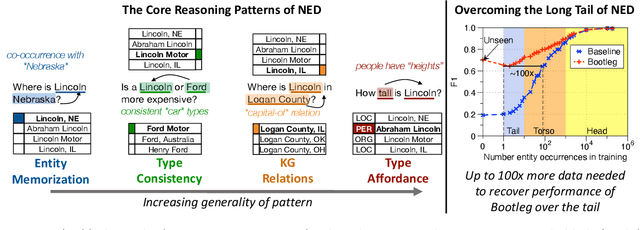
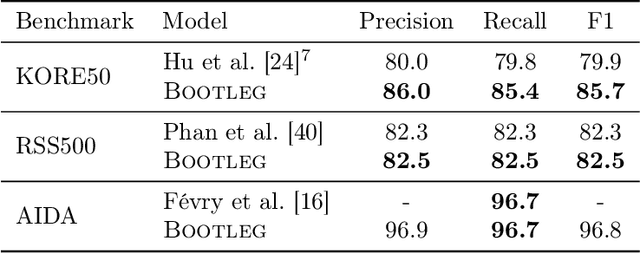
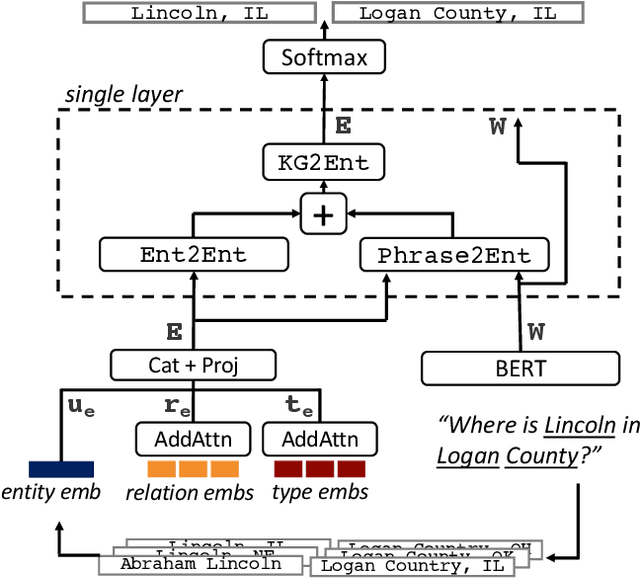

Abstract:A challenge for named entity disambiguation (NED), the task of mapping textual mentions to entities in a knowledge base, is how to disambiguate entities that appear rarely in the training data, termed tail entities. Humans use subtle reasoning patterns based on knowledge of entity facts, relations, and types to disambiguate unfamiliar entities. Inspired by these patterns, we introduce Bootleg, a self-supervised NED system that is explicitly grounded in reasoning patterns for disambiguation. We define core reasoning patterns for disambiguation, create a learning procedure to encourage the self-supervised model to learn the patterns, and show how to use weak supervision to enhance the signals in the training data. Encoding the reasoning patterns in a simple Transformer architecture, Bootleg meets or exceeds state-of-the-art on three NED benchmarks. We further show that the learned representations from Bootleg successfully transfer to other non-disambiguation tasks that require entity-based knowledge: we set a new state-of-the-art in the popular TACRED relation extraction task by 1.0 F1 points and demonstrate up to 8% performance lift in highly optimized production search and assistant tasks at a major technology company
Sharp Bias-variance Tradeoffs of Hard Parameter Sharing in High-dimensional Linear Regression
Oct 22, 2020


Abstract:Hard parameter sharing for multi-task learning is widely used in empirical research despite the fact that its generalization properties have not been well established in many cases. This paper studies its generalization properties in a fundamental setting: How does hard parameter sharing work given multiple linear regression tasks? We develop new techniques and establish a number of new results in the high-dimensional setting, where the sample size and feature dimension increase at a fixed ratio. First, we show a sharp bias-variance decomposition of hard parameter sharing, given multiple tasks with the same features. Second, we characterize the asymptotic bias-variance limit for two tasks, even when they have arbitrarily different sample size ratios and covariate shifts. We also demonstrate that these limiting estimates for the empirical loss are incredibly accurate in moderate dimensions. Finally, we explain an intriguing phenomenon where increasing one task's sample size helps another task initially by reducing variance but hurts eventually due to increasing bias. This suggests progressively adding data for optimizing hard parameter sharing, and we validate its efficiency in text classification tasks.
Train and You'll Miss It: Interactive Model Iteration with Weak Supervision and Pre-Trained Embeddings
Jun 26, 2020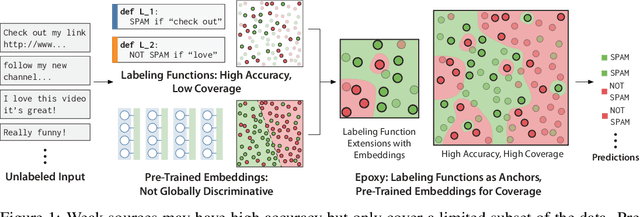
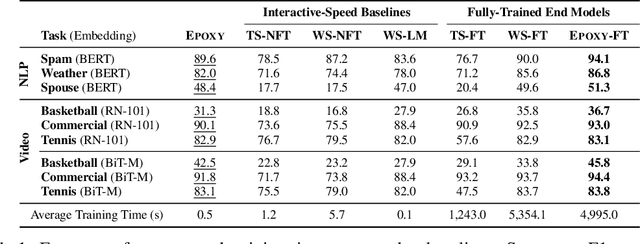
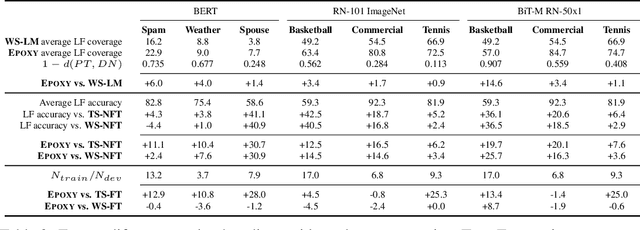
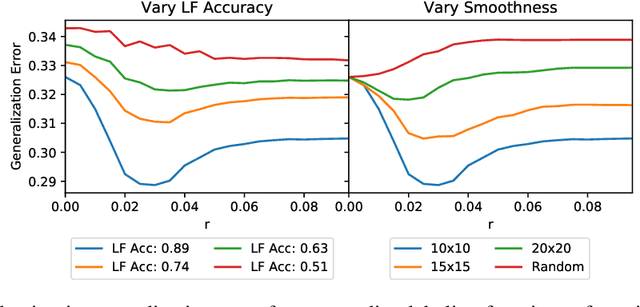
Abstract:Our goal is to enable machine learning systems to be trained interactively. This requires models that perform well and train quickly, without large amounts of hand-labeled data. We take a step forward in this direction by borrowing from weak supervision (WS), wherein models can be trained with noisy sources of signal instead of hand-labeled data. But WS relies on training downstream deep networks to extrapolate to unseen data points, which can take hours or days. Pre-trained embeddings can remove this requirement. We do not use the embeddings as features as in transfer learning (TL), which requires fine-tuning for high performance, but instead use them to define a distance function on the data and extend WS source votes to nearby points. Theoretically, we provide a series of results studying how performance scales with changes in source coverage, source accuracy, and the Lipschitzness of label distributions in the embedding space, and compare this rate to standard WS without extension and TL without fine-tuning. On six benchmark NLP and video tasks, our method outperforms WS without extension by 4.1 points, TL without fine-tuning by 12.8 points, and traditionally-supervised deep networks by 13.1 points, and comes within 0.7 points of state-of-the-art weakly-supervised deep networks-all while training in less than half a second.
Understanding and Improving Information Transfer in Multi-Task Learning
May 02, 2020



Abstract:We investigate multi-task learning approaches that use a shared feature representation for all tasks. To better understand the transfer of task information, we study an architecture with a shared module for all tasks and a separate output module for each task. We study the theory of this setting on linear and ReLU-activated models. Our key observation is that whether or not tasks' data are well-aligned can significantly affect the performance of multi-task learning. We show that misalignment between task data can cause negative transfer (or hurt performance) and provide sufficient conditions for positive transfer. Inspired by the theoretical insights, we show that aligning tasks' embedding layers leads to performance gains for multi-task training and transfer learning on the GLUE benchmark and sentiment analysis tasks; for example, we obtain a 2.35% GLUE score average improvement on 5 GLUE tasks over BERT-LARGE using our alignment method. We also design an SVD-based task reweighting scheme and show that it improves the robustness of multi-task training on a multi-label image dataset.
On the Generalization Effects of Linear Transformations in Data Augmentation
May 02, 2020



Abstract:Data augmentation is a powerful technique to improve performance in applications such as image and text classification tasks. Yet, there is little rigorous understanding of why and how various augmentations work. In this work, we consider a family of linear transformations and study their effects on the ridge estimator in an over-parametrized linear regression setting. First, we show that transformations which preserve the labels of the data can improve estimation by enlarging the span of the training data. Second, we show that transformations which mix data can improve estimation by playing a regularization effect. Finally, we validate our theoretical insights on MNIST. Based on the insights, we propose an augmentation scheme that searches over the space of transformations by how uncertain the model is about the transformed data. We validate our proposed scheme on image and text datasets. For example, our method outperforms RandAugment by 1.24% on CIFAR-100 using Wide-ResNet-28-10. Furthermore, we achieve comparable accuracy to the SoTA Adversarial AutoAugment on CIFAR datasets.
Ivy: Instrumental Variable Synthesis for Causal Inference
Apr 11, 2020
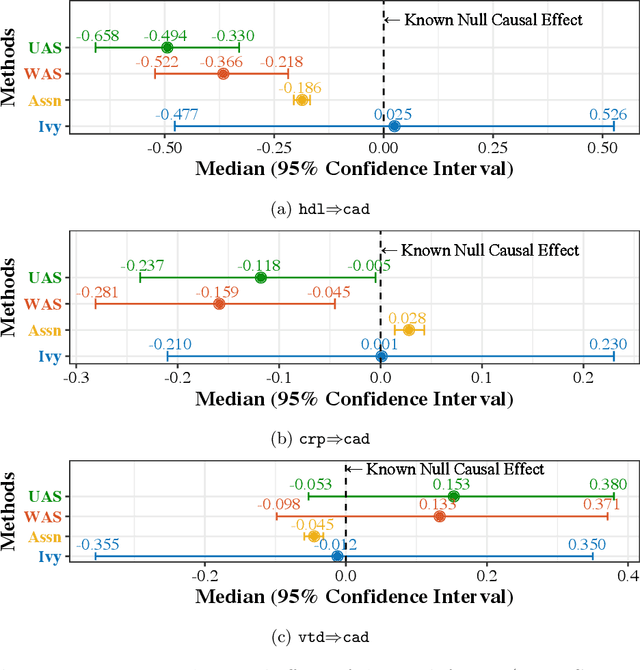

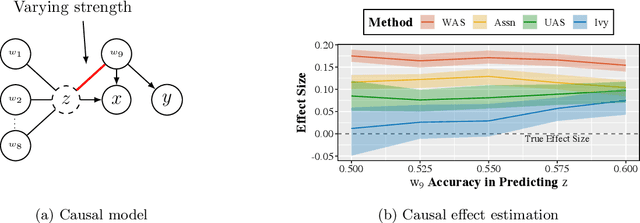
Abstract:A popular way to estimate the causal effect of a variable x on y from observational data is to use an instrumental variable (IV): a third variable z that affects y only through x. The more strongly z is associated with x, the more reliable the estimate is, but such strong IVs are difficult to find. Instead, practitioners combine more commonly available IV candidates---which are not necessarily strong, or even valid, IVs---into a single "summary" that is plugged into causal effect estimators in place of an IV. In genetic epidemiology, such approaches are known as allele scores. Allele scores require strong assumptions---independence and validity of all IV candidates---for the resulting estimate to be reliable. To relax these assumptions, we propose Ivy, a new method to combine IV candidates that can handle correlated and invalid IV candidates in a robust manner. Theoretically, we characterize this robustness, its limits, and its impact on the resulting causal estimates. Empirically, Ivy can correctly identify the directionality of known relationships and is robust against false discovery (median effect size <= 0.025) on three real-world datasets with no causal effects, while allele scores return more biased estimates (median effect size >= 0.118).
Understanding the Downstream Instability of Word Embeddings
Feb 29, 2020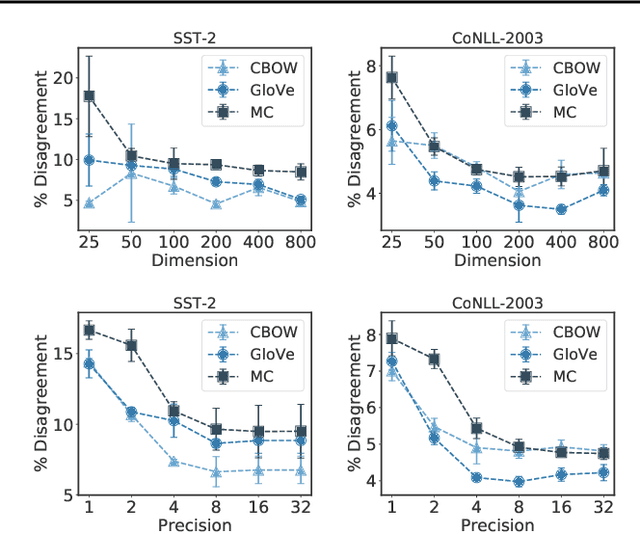



Abstract:Many industrial machine learning (ML) systems require frequent retraining to keep up-to-date with constantly changing data. This retraining exacerbates a large challenge facing ML systems today: model training is unstable, i.e., small changes in training data can cause significant changes in the model's predictions. In this paper, we work on developing a deeper understanding of this instability, with a focus on how a core building block of modern natural language processing (NLP) pipelines---pre-trained word embeddings---affects the instability of downstream NLP models. We first empirically reveal a tradeoff between stability and memory: increasing the embedding memory 2x can reduce the disagreement in predictions due to small changes in training data by 5% to 37% (relative). To theoretically explain this tradeoff, we introduce a new measure of embedding instability---the eigenspace instability measure---which we prove bounds the disagreement in downstream predictions introduced by the change in word embeddings. Practically, we show that the eigenspace instability measure can be a cost-effective way to choose embedding parameters to minimize instability without training downstream models, outperforming other embedding distance measures and performing competitively with a nearest neighbor-based measure. Finally, we demonstrate that the observed stability-memory tradeoffs extend to other types of embeddings as well, including knowledge graph and contextual word embeddings.
 Add to Chrome
Add to Chrome Add to Firefox
Add to Firefox Add to Edge
Add to Edge